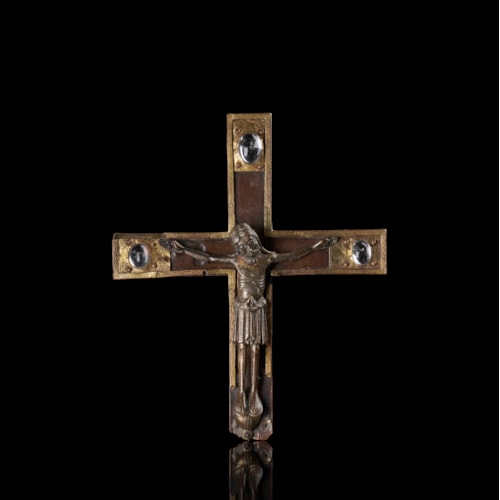18780

Virgin and Child seated under a canopy
Virgin and Child seated under a canopy

Virgin and Child seated under a canopy
Southern Netherlands/Bruges(?)
15th century
17.5 x 9.5 cm (6 ⁷/₈ x 3 ³/₄ inches)
Ivory
accompanied by European Cites certificate
SOLD
phone 0032 3 314 90 34 – mobile 0032476 963 483.
PROVENANCE
Former Henri Oppenheimer collection
Christie's London, 15th July 1936, lot 118
Jacques Bacri collection, Paris
ADDITIONAL PICTURES




READ
FULL DESCRIPTION
This rare and very beautiful crowned Virgin and Child, enthroned beneath a canopy whose curtains are being drawn back by angels, was made in the fifteenth century, most likely in the Netherlands. The ivory, whose small size suggests that it was produced for private devotion, was in the collection of the banker Henry Oppenheimer (1859-1932) until his death. It was described as French when it was shown in the 1923 exhibition of the finest European ivories at the Burlington Fine Arts Club (attached a pdf file from the catalogue of this exhibition.) in London, but an attribution to a regional school is in reality more complex, given the work's unique qualities. However, the physiognomy of the figures, with their round faces and bulging foreheads, as well as their slender fingers, suggests a Netherlandish origin.
Provenance:
Former Henri Oppenheimer collection
Christie's London, 15th July 1936, lot 118
Jacques Bacri collection, Paris
In France, the making of ivory objects was somewhat interrupted at the beginning of the fifteenth century because of the economic consequences of the Hundred Years' War, but other centers of production emerged across Europe. In Flanders and the Netherlands. the art flourished particularly in Bruges and Utrecht, where a fresh approach to the traditions and methods of ivory carving evolved.
There’s another comparable Virgin and Child Enthroned in the Wyvern collection.
There is also a certain similarity between a Netherlandish relief in the V&A Museum in London . This was also made in the Netherlands towards the end of the fifteenth century and shows a Virgo Lactans accompanied by musician angels. The Virgin's face has the same gentle quality and the facial features are also comparable, with the prominent bare forehead. The stylistic similarities are most striking in the figures of the angels.
Fine and cleaned condition, with a small repair at the head of the left Angel.
Related Literature
Burlington Fine Arts Club, exh. cat. London, 1923, cat. no. 158, p. 91; R. Koechlin, Les Ivoires Gothiques Français, t.II, Paris, 1924, no. 984, p. 361; R. H. Randall Jr., "Dutch Ivories of the Fifteenth Century", Nederlands Kunsthistorisch Jaarboek (NKJ)/ Netherlands Yearbook for History of Art, 1994, vol. 45, pp. 127-139; S. Vandenberghe, Ivory in Bruges: Treasures from Museums, Churches and Monasteries, Bruges,
2010; J. Warren, Medieval and Renaissance sculpture. Sculptures in Stone, Clay, Ivory, Bone and Wood, exh. cat. Ashmolean Museum, Oxford, 2014;
P. Williamson, G. Davies, Medieval Ivory Carvings 1200-1550, Part I, London, 2014, pp. 68 -69, cat. P. Williamson, The Wyvern collection, Medieval and later Ivory carvings and Small sculptures,
no. 17;
Londres, 2019, cat. 156, p. 303.
Provenance:
Former Henri Oppenheimer collection
Christie's London, 15th July 1936, lot 118
Jacques Bacri collection, Paris
In France, the making of ivory objects was somewhat interrupted at the beginning of the fifteenth century because of the economic consequences of the Hundred Years' War, but other centers of production emerged across Europe. In Flanders and the Netherlands. the art flourished particularly in Bruges and Utrecht, where a fresh approach to the traditions and methods of ivory carving evolved.
There’s another comparable Virgin and Child Enthroned in the Wyvern collection.
There is also a certain similarity between a Netherlandish relief in the V&A Museum in London . This was also made in the Netherlands towards the end of the fifteenth century and shows a Virgo Lactans accompanied by musician angels. The Virgin's face has the same gentle quality and the facial features are also comparable, with the prominent bare forehead. The stylistic similarities are most striking in the figures of the angels.
Fine and cleaned condition, with a small repair at the head of the left Angel.
Related Literature
Burlington Fine Arts Club, exh. cat. London, 1923, cat. no. 158, p. 91; R. Koechlin, Les Ivoires Gothiques Français, t.II, Paris, 1924, no. 984, p. 361; R. H. Randall Jr., "Dutch Ivories of the Fifteenth Century", Nederlands Kunsthistorisch Jaarboek (NKJ)/ Netherlands Yearbook for History of Art, 1994, vol. 45, pp. 127-139; S. Vandenberghe, Ivory in Bruges: Treasures from Museums, Churches and Monasteries, Bruges,
2010; J. Warren, Medieval and Renaissance sculpture. Sculptures in Stone, Clay, Ivory, Bone and Wood, exh. cat. Ashmolean Museum, Oxford, 2014;
P. Williamson, G. Davies, Medieval Ivory Carvings 1200-1550, Part I, London, 2014, pp. 68 -69, cat. P. Williamson, The Wyvern collection, Medieval and later Ivory carvings and Small sculptures,
no. 17;
Londres, 2019, cat. 156, p. 303.




